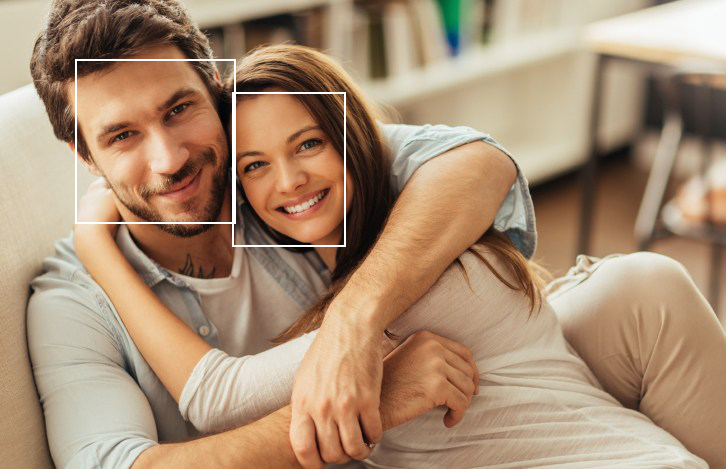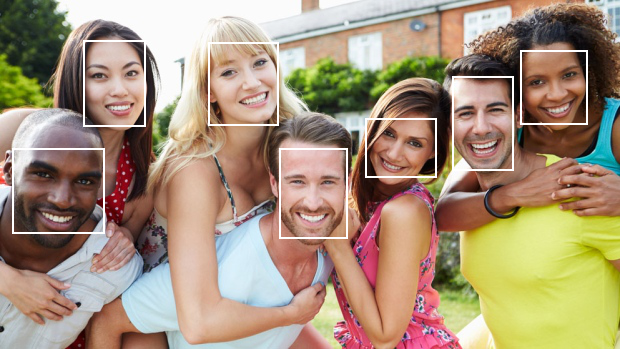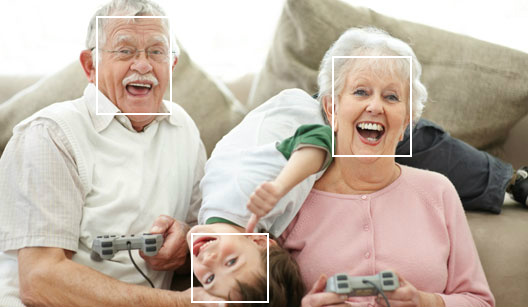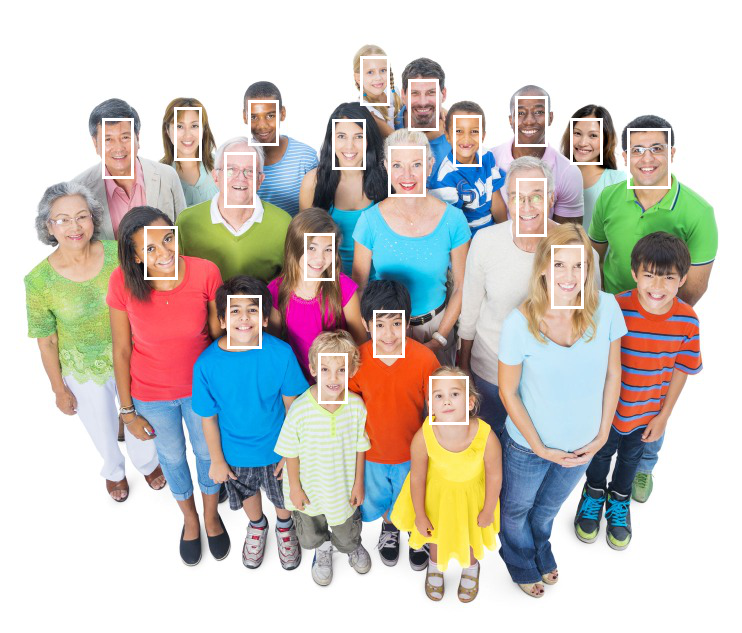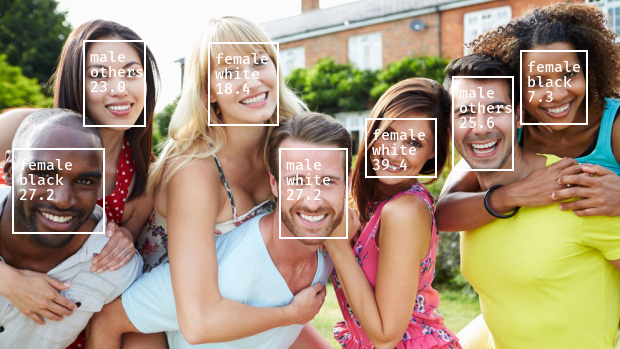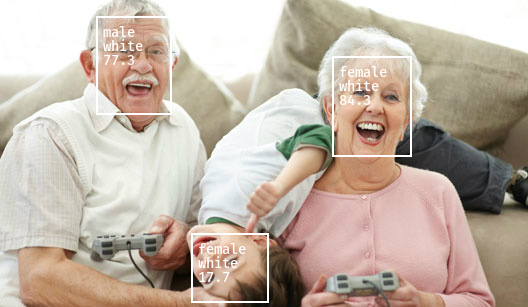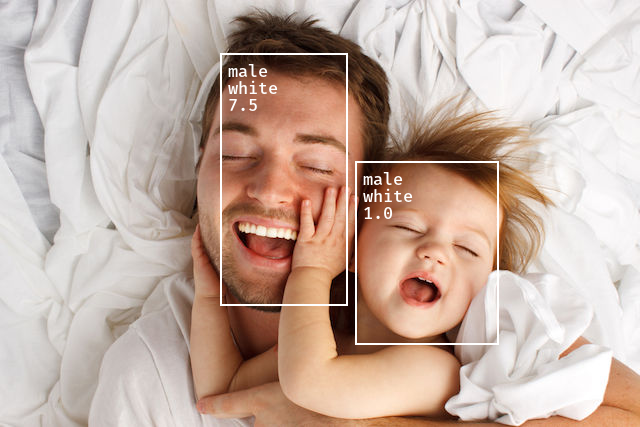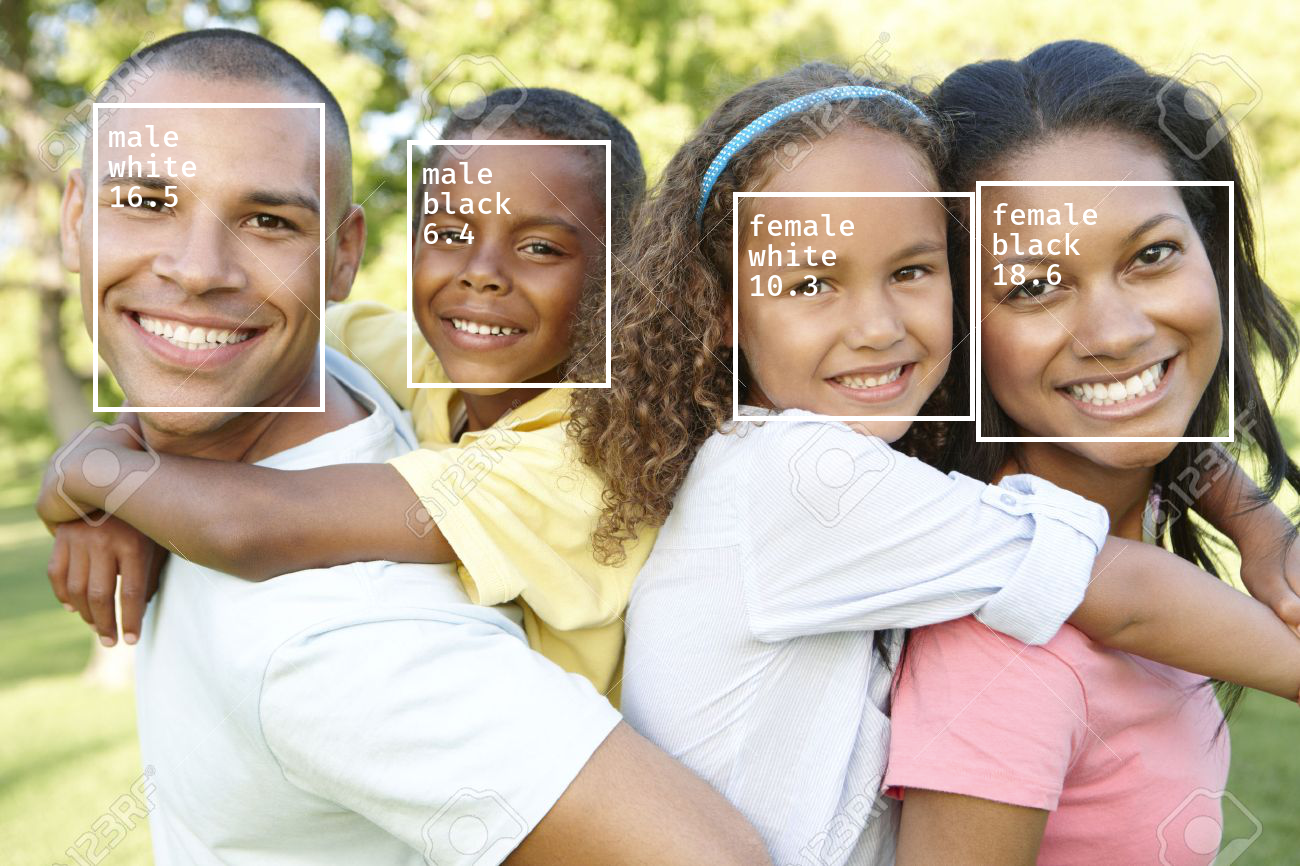概要
Darknet YOLO v3をWIDER FACEデータセットで学習させてweightを作成
weightとYOLO v3ネットワークを使って、KerasにコンバートしたYOLO v3モデルを構築
Keras YOLO v3モデルで顔検出
過去に構築したモデルを使って、検出した顔画像から性別・人種・年齢を予測
これらのタスクを分割して掲載
- [YOLO v3による顔検出:01.データセット準備]
(https://qiita.com/ha9kberry/items/1bc113cfcd9892a9ddbd) - [YOLO v3による顔検出:02.Darknetで学習]
(https://qiita.com/ha9kberry/items/e7c822dd0874e5a24639) - YOLO v3による顔検出:03.Kerasで予測
Keras YOLO v3
インストール
# clone
$ git clone https://github.com/qqwweee/keras-yolo3.git
$ cd keras-yolo3
yolov3.cfg編集
*filters=(classes+5)3
Line 603:filters=18に設定
Line 610:classes=1に設定
Line 689:filters=18に設定
Line 696:classes=1に設定
Line 776:filters=18に設定
Line 783:classes=1に設定
...
[convolutional]
size=1
stride=1
pad=1
filters=18
activation=linear
[yolo]
mask = 0,1,2
anchors = 10,13, 16,30, 33,23, 30,61, 62,45, 59,119, 116,90, 156,198, 373,326
classes=1
num=9
jitter=.3
ignore_thresh = .7
truth_thresh = 1
random=1
Kerasモデルにコンバート
前回のDarknet YOLO v3で学習した最終weightをyolov3.weightsにリネームして、同ディレクトリ直下に保存
YOLO v3のcfgとweightを使って、Keras YOLO v3モデルを生成
python convert.py yolov3.cfg yolov3.weights yolov3.h5
classes.txt作成
同ディレクトリ直下に保存
face
顔検出
yolo.pyをコピーしてyolo.ipynbを作成(一部編集)
import numpy as np
import pandas as pd
import matplotlib.pyplot as plt
%config InlineBackend.figure_formats = {'png', 'retina'}
import os, colorsys
from keras import backend as K
from keras.models import load_model
from keras.layers import Input
from keras.utils import multi_gpu_model
from PIL import Image, ImageFont, ImageDraw
from timeit import default_timer as timer
from yolo3.model import yolo_eval, yolo_body, tiny_yolo_body
from yolo3.utils import letterbox_image
class YOLO(object):
_defaults = {
"model_path": 'yolov3.h5',
# bounding boxのアスペクト比
"anchors_path": 'model_data/yolo_anchors.txt',
#"anchors_path": 'model_data/tiny_yolo_anchors.txt',
"classes_path": 'classes.txt',
"score" : 0.3,
"iou" : 0.45,
# 入力画像の32 x 32ピクセルが特徴マップ上の1ピクセルに対応
# よって入力画像の幅と高さは32の倍数
"model_image_size" : (416, 416),
"gpu_num" : 1,
}
@classmethod
def get_defaults(cls, n):
if n in cls._defaults:
return cls._defaults[n]
else:
return "Unrecognized attribute name '" + n + "'"
def __init__(self, **kwargs):
self.__dict__.update(self._defaults) # set up default values
self.__dict__.update(kwargs) # and update with user overrides
self.class_names = self._get_class()
self.anchors = self._get_anchors()
self.sess = K.get_session()
self.boxes, self.scores, self.classes = self.generate()
def _get_class(self):
# ~をホームディレクトリパスに置換
classes_path = os.path.expanduser(self.classes_path)
# ファイル読み込み(自動でclose)
with open(classes_path) as f:
# 1行毎にファイル終端まで全て読む(改行文字も含む)
class_names = f.readlines()
# 空白文字、改行文字削除
class_names = [c.strip() for c in class_names]
return class_names
def _get_anchors(self):
anchors_path = os.path.expanduser(self.anchors_path)
with open(anchors_path) as f:
# 1行を文字列として1行毎に読み込む(改行文字も含む)
anchors = f.readline()
# floatで改行文字消去
anchors = [float(x) for x in anchors.split(',')]
# 2列の2次元配列に変換
return np.array(anchors).reshape(-1, 2)
def generate(self):
model_path = os.path.expanduser(self.model_path)
# h5ファイル以外はAssertion Error
# assert model_path.endswith('.h5'), 'Keras model or weights must be a .h5 file.'
# Load model, or construct model and load weights.
num_anchors = len(self.anchors)
num_classes = len(self.class_names)
# num_anchors==6ならばTrue
is_tiny_version = num_anchors==6 # default setting
try:
# 以降学習しない OR モデル保存時にinclude_optimizer=False
self.yolo_model = load_model(model_path, compile=False)
except:
self.yolo_model = tiny_yolo_body(Input(shape=(None,None,3)), num_anchors//2, num_classes) \
if is_tiny_version else yolo_body(Input(shape=(None,None,3)), num_anchors//3, num_classes)
self.yolo_model.load_weights(self.model_path) # make sure model, anchors and classes match
else:
assert self.yolo_model.layers[-1].output_shape[-1] == \
num_anchors/len(self.yolo_model.output) * (num_classes + 5), \
'Mismatch between model and given anchor and class sizes'
#print('{} model, anchors, and classes loaded.'.format(model_path))
# Generate colors for drawing bounding boxes.
hsv_tuples = [(x / len(self.class_names), 1., 1.)
for x in range(len(self.class_names))]
self.colors = list(map(lambda x: colorsys.hsv_to_rgb(*x), hsv_tuples))
self.colors = list(
map(lambda x: (int(x[0] * 255), int(x[1] * 255), int(x[2] * 255)),
self.colors))
np.random.seed(10101) # Fixed seed for consistent colors across runs.
np.random.shuffle(self.colors) # Shuffle colors to decorrelate adjacent classes.
np.random.seed(None) # Reset seed to default.
# Generate output tensor targets for filtered bounding boxes.
self.input_image_shape = K.placeholder(shape=(2, ))
if self.gpu_num>=2:
# multi_gpu_model:複数GPUによる並列バッチ処理
self.yolo_model = multi_gpu_model(self.yolo_model, gpus=self.gpu_num)
boxes, scores, classes = yolo_eval(
self.yolo_model.output,
self.anchors,
len(self.class_names),
self.input_image_shape,
score_threshold=self.score,
iou_threshold=self.iou
)
return boxes, scores, classes
def detect_image(self, image):
start = timer()
# 画像をRGBに変換(追記)
image=image.convert('RGB')
if self.model_image_size != (None, None):
assert self.model_image_size[0]%32 == 0, 'Multiples of 32 required'
assert self.model_image_size[1]%32 == 0, 'Multiples of 32 required'
# アスペクト比を変えずに余白を使って画像をmodel_image_sizeにリサイズ
boxed_image = letterbox_image(image, tuple(reversed(self.model_image_size)))
else:
new_image_size = (image.width - (image.width % 32),
image.height - (image.height % 32))
boxed_image = letterbox_image(image, new_image_size)
# 画像を配列に変換
image_data = np.array(boxed_image, dtype='float32')
#print(image_data.shape)
# 正規化
image_data /= 255
# 軸を指定して次元追加
image_data = np.expand_dims(image_data, 0) # Add batch dimension.
# TensorFlow
out_boxes, out_scores, out_classes = self.sess.run(
[self.boxes, self.scores, self.classes],
feed_dict={
self.yolo_model.input: image_data,
self.input_image_shape: [image.size[1], image.size[0]],
K.learning_phase(): 0
})
print('Found {} boxes for {}'.format(len(out_boxes), 'img'))
font = ImageFont.truetype(font='font/FiraMono-Medium.otf',
size=np.floor(3e-2 * image.size[1] + 0.5).astype('int32'))
thickness = (image.size[0] + image.size[1]) // 400
detect_dict=[]
for i, c in enumerate(out_classes):
predicted_class = self.class_names[c]
box = out_boxes[i]
score = out_scores[i]
#label = '{} {:.2f}'.format(predicted_class, score)
draw = ImageDraw.Draw(image)
#label_size = draw.textsize(label, font)
top, left, bottom, right = box
top = max(0, np.floor(top + 0.5).astype('int32'))
left = max(0, np.floor(left + 0.5).astype('int32'))
bottom = min(image.size[1], np.floor(bottom + 0.5).astype('int32'))
right = min(image.size[0], np.floor(right + 0.5).astype('int32'))
#print(label, (left, top), (right, bottom))
# if top - label_size[1] >= 0:
# text_origin = np.array([left, top - label_size[1]])
# else:
# text_origin = np.array([left, top + 1])
# My kingdom for a good redistributable image drawing library.
for i in range(thickness):
draw.rectangle(
[left + i, top + i, right - i, bottom - i],
#outline=self.colors[c]
outline=(255, 255, 255)
)
# draw.rectangle(
# [tuple(text_origin), tuple(text_origin + label_size)],
# fill=self.colors[c])
#draw.text(text_origin, label, fill=(0, 0, 0), font=font)
del draw
detect_dict.append({
#'label': label,
#'class': predicted_class,
'score': score,
'left': left,
'top': top,
'right': right,
'bottom': bottom
})
end = timer()
#print(round(end - start, 2),"s")
return image, detect_dict
def close_session(self):
self.sess.close()
def detect_video(yolo, video_path, output_path=""):
import cv2
vid = cv2.VideoCapture(video_path)
if not vid.isOpened():
raise IOError("Couldn't open webcam or video")
video_FourCC = int(vid.get(cv2.CAP_PROP_FOURCC))
video_fps = vid.get(cv2.CAP_PROP_FPS)
video_size = (int(vid.get(cv2.CAP_PROP_FRAME_WIDTH)),
int(vid.get(cv2.CAP_PROP_FRAME_HEIGHT)))
isOutput = True if output_path != "" else False
if isOutput:
print("!!! TYPE:", type(output_path), type(video_FourCC), type(video_fps), type(video_size))
out = cv2.VideoWriter(output_path, video_FourCC, video_fps, video_size)
accum_time = 0
curr_fps = 0
fps = "FPS: ??"
prev_time = timer()
while True:
return_value, frame = vid.read()
image = Image.fromarray(frame)
image, detect_dict = yolo.detect_image(image)
result = np.asarray(image)
curr_time = timer()
exec_time = curr_time - prev_time
prev_time = curr_time
accum_time = accum_time + exec_time
curr_fps = curr_fps + 1
if accum_time > 1:
accum_time = accum_time - 1
fps = "FPS: " + str(curr_fps)
curr_fps = 0
cv2.putText(result, text=fps, org=(3, 15), fontFace=cv2.FONT_HERSHEY_SIMPLEX,
fontScale=0.50, color=(255, 0, 0), thickness=2)
cv2.namedWindow("result", cv2.WINDOW_NORMAL)
cv2.imshow("result", result)
if isOutput:
out.write(result)
if cv2.waitKey(1) & 0xFF == ord('q'):
break
yolo.close_session()
%%time
# インスタンス作成
yolo = YOLO()
CPU times: user 10.2 s, sys: 683 ms, total: 10.8 s
Wall time: 10.6 s
%%time
image = Image.open("photos/photo.jpg")
r_image, r_detect_dict = yolo.detect_image(image)
Found 2 boxes for img
CPU times: user 5.32 s, sys: 846 ms, total: 6.16 s
Wall time: 2.13 s
r_image
r_detect_dict
[{'score': 0.96726614, 'left': 232, 'top': 92, 'right': 345, 'bottom': 246},
{'score': 0.800036, 'left': 75, 'top': 59, 'right': 235, 'bottom': 223}]
顔検出できているほうかなと
そのほかの写真でも検出してみる
顔が反転していても検出できている
20個の顔検出
検出数には上限設定があるのかも
性別・人種・年齢を予測
検出画像をクロップして、以前構築したモデルを使って回帰・分類させる
各種モデル読み込み
モデルファイルをkeras-yolo3直下に保存
%%time
model_gender = load_model('model-opt_gender.hdf5', compile=False)
model_race = load_model('model-opt_race.hdf5', compile=False)
model_age = load_model('model-opt_age.hdf5', compile=False)
CPU times: user 22.4 s, sys: 870 ms, total: 23.2 s
Wall time: 22.8 s
# クラス
classes_gender = ["male", "female"]
classes_race = ["white", "black", "asian", "indian", "others"]
# 画像入力サイズ
input_size = 100
検出画像をクロップして配列に格納
arrays = []
for i in range(len(r_detect_dict)):
left = r_detect_dict[i]["left"]
top = r_detect_dict[i]["top"]
right = r_detect_dict[i]["right"]
bottom = r_detect_dict[i]["bottom"]
# 元画像をcrop
crop=image.crop((left, top, right, bottom))
resize = crop.resize((input_size, input_size)) #resize=resizeSquare(crop, input_size)
# 画像データを配列に変換
array = np.asarray(resize)
arrays.append(array)
# 配列のリストを配列に変換
arrays = np.array(arrays)
arrays.shape
(2, 100, 100, 3)
# データ型の変換&正規化
arrays = arrays.astype('float32')
arrays /= 255
各種モデル予測
%%time
# 性別予測
pred_classes_gender=np.argmax(model_gender.predict(arrays), axis=1)
# 性別予測確率
pred_probs_gender = np.max(model_gender.predict(arrays),axis=1)
# 種別予測
pred_classes_race=np.argmax(model_race.predict(arrays), axis=1)
# 種別予測確率
pred_probs_race = np.max(model_race.predict(arrays),axis=1)
# 年齢予測
pred_probs_age=model_age.predict(arrays)
CPU times: user 2.36 s, sys: 794 ms, total: 3.16 s
Wall time: 1.12 s
予測結果を出力
%%time
size=np.floor(3e-2 * r_image.size[1] + 5).astype('int32')
draw = ImageDraw.Draw(r_image)
font = ImageFont.truetype(
font='font/FiraMono-Medium.otf',
size=size
)
for i in range(len(r_detect_dict)):
score = r_detect_dict[i]["score"]
left = r_detect_dict[i]["left"]
top = r_detect_dict[i]["top"]
gender = classes_gender[pred_classes_gender[i]]
gender_score = pred_probs_gender[i]
race = classes_race[pred_classes_race[i]]
race_score = pred_probs_race[i]
age = round(pred_probs_age[i][0],1)
draw.text((left+size*0.5, top+size*0.5), gender, fill=(255, 255, 255), font=font)
draw.text((left+size*0.5, top+size*1.5), race, fill=(255, 255, 255), font=font)
draw.text((left+size*0.5, top+size*2.5), str(age), fill=(255, 255, 255), font=font)
CPU times: user 3.16 ms, sys: 3.89 ms, total: 7.05 ms
Wall time: 9.42 ms
r_image
for i in range(len(r_detect_dict)):
score = r_detect_dict[i]["score"]
left = r_detect_dict[i]["left"]
top = r_detect_dict[i]["top"]
gender = classes_gender[pred_classes_gender[i]]
gender_score = pred_probs_gender[i]
race = classes_race[pred_classes_race[i]]
race_score = pred_probs_race[i]
age = round(pred_probs_age[i][0],1)
print('score : {:.4f}'.format(score))
print('gender : {}({:.4f})'.format(gender, gender_score))
print('race : {}({:.4f})'.format(race, race_score))
print('age : {:.1f}'.format(age))
print('')
score : 0.9673
gender : female(0.9967)
race : others(0.9282)
age : 21.0
score : 0.8000
gender : male(0.9141)
race : white(0.8318)
age : 26.4
予測できているほうかなと
そのほかの写真でも予測してみる
特に年齢回帰モデルの精度はまだまだかなと
ディレクトリ構成
keras-yolo3/
┣ font/
┣ model_data/
┣ photos/
┣ yolo3/
┣ yolov3.cfg
┣ convert.py
┣ yolo.py
┣ model-opt_age.hdf5
┣ model-opt_gender.hdf5
┣ model-opt_race.hdf5
┣ yolo.ipynb
┣ yolov3.h5
┣ yolov3.weights
┣ classes.txt
...
